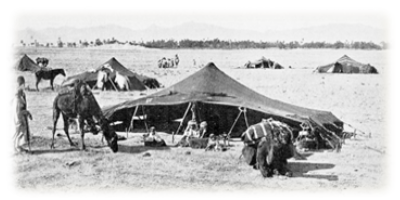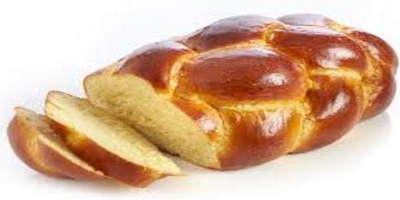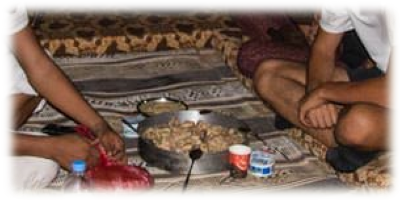Topics  Manners & Customs Manners & Customs 
 Excerpts from Manners and Customs of Bible Lands
Excerpts from Manners and Customs of Bible Lands
By Fred H. Wight
Tent dwellings
In the Bible, living in tents is of ancient origin. It goes back before the days of Abraham. The first reference in the Scriptures to tent life is concerning the man Jabal, of whom it is said, "he was the father of such as dwell in tents" (Gen. 4:20). Following the Flood the Sacred Record says, "God shall enlarge Japheth, and he shall dwell in the tents of Shem" (Gen. 9:27).
The patriarchs Abraham, Isaac, and Jacob lived most of their lives in tents, in and around the land of Canaan. It was said of Abraham that he "pitched his tent" in the vicinity of Bethel (Gen. 12:8), that Isaac "pitched his tent in the valley of Gerar" (Gen. 26:17), and Jacob "Pitched his tent before the city of Shechem" (Gen. 33:18).
The Children of Israel lived in tents during their forty years in the wilderness. Moses said of them, "The children of Israel shall pitch their tents, every man by his own camp" (Num. 1:52). And Balaam "lifted up his eyes, and he saw Israel abiding in his tents according to their tribes" (Num. 24:2).
For many years after the entering of the Promised Land, Israel still lived in tents. In the days of David it was said to the King, "The ark and Israel and Judah, abide in tents" (2Sam. 11:11), indicating that many of the people at that time were tent- dwellers. Even at the time of the revolt of the ten tribes under Jeroboam and their separation from Judah, the cry went forth, "To your tents, O Israel" (1Kings 12:16). When the tribes gathered together at such small places as Gilgal, and Shiloh, they undoubtedly brought their tents with them. And after the temple was built at Jerusalem the people would make their pilgrimages there to celebrate the feasts of the Lord, and many thousands of them would sleep in tents on the mountains surrounding the city.
Like the Jews of old, the Nomad or Bedouin Arabs of Palestine, and especially those of Trans-Jordan, have been living in tents for centuries, and their manner of life is strikingly like unto that of the early Bible characters. A study, therefore, of these tent structures of Bible lands of today will throw much light on how the men of early Bible times actually lived. By such a study one can build the proper background for understanding the life and contributions of these men of the long ago.
Tent material
The Bedouin's home is his tent, which is made of black goat's hair. He calls it beit sha'ar , i.e., "house of hair." It is made of coarse, heavy fabric, and serves to protect the family in winter from the cold winds; in the summer the sides are usually lifted, and the tent serves as a sunshade. This goat's hair cloth that is used in making these tents is porous when it is dry, but becomes waterproof after the first rains have shrunk it together. The Song of Solomon refers to these black goat's hair tents thus: "I am black, but comely, O ye daughters of Jerusalem, as the tents of Kedar" (Cant 1:5).
The material that makes up the Bedouin tent is the same as the sackcloth of Bible days. It must be remembered that this Oriental sackcloth is not at all like the Occidental burlap, but is rather a material made of prickly, coarse goat's hair. The Apostle John compares darkness to this sackcloth: "the sun became black like sackcloth of hair" (Rev. 6:12). In Bible times sackcloth was worn as a sign of sorrow (Gen. 37:34; 2Sam. 3:31), as a sign of humility (1Kings 21:27; 2Kings 19:1), or as a sign of repentance (Dan. 9:3; Jonah 3:5).
Tent encampments and manner of setting up of tents
If the Bedouin Arabs live together as a tribe or a clan, as they often do, or if more than one family dwell with each other, then their tents are not pitched in a promiscuous cluster, but more likely in a large circle to make it possible for at least some of their flocks to be protected inside the circle. By the side of the sheik's tent stands a long spear as an emblem of his authority (cf. practice of King Saul in 1Sam. 26:7). His tent is generally larger than the others.
The Bible says that some of the sons of Ishmael lived in tent villages or encampments (Gen. 25:16, A. R. V.). The number of tents that made up the encampment of Abraham must have been large, for in his warfare against the confederacy of kings that took Lot captive, it is stated that he used a band of three hundred eighteen trained soldiers born in his household (Gen. 14:14). The arrangement of his tents was doubtless much like that of the wealthier Bedouin Arabs of today. The main overhead portion of the Bedouin's tent is composed of one large awning which is held up by poles, and the ends of the tent cloth are drawn out by cords which are tied to pegs and driven into the ground. It was one of these tent pins that Jael used in killing Sisera (Judges 4:21).
Inside arrangement of tent
The Oriental tent is usually oblong in shape, and is divided into two, and sometimes three apartments by goat's hair curtains. The entrance leads into the apartment for the men, which also serves as the reception apartment. Beyond this is the apartment for the women and children. And sometimes there is a third apartment for servants or for cattle.
The women in the inner apartment are screened from the view of those in the reception room, but they can hear what goes on in that room. Thus Sarah in her apartment overheard what the angel guest said in the reception apartment of Abraham's tent (Gen. 18:10-15). In some cases there is a separate tent for the women. It took several tents to care for the large family of Jacob. Reference is made to Jacob's tent, to Leah's tent, to Rachel's tent, and to the tent of the two maidservants; (Gen. 31:33).
Inside furnishings of tents
The shepherd's tent is always subject to perpetual removals, as Hezekiah indicated in his song of thanksgiving, after his recovery from sickness (Isa. 38:12). Therefore, the furnishings of that tent must include only the necessities. Rugs cover the ground, but at night the bedding is brought out, which is composed of mats, or carpets on which to sleep; and their outer garments worn by day become their coverings by night. Sacks of grain are apt to be piled around the middle tent posts. Sure to be about the tent some place are the handmill, and the mortar, in which the grain is pounded. And hanging from the poles will be the skin bags or bottles, for water and other liquids. Also there will be a leathern bucket with which to draw water from any well that may be available, and an earthen pitcher, used by the women to carry the water. Cooking utensils will not be many, but will include pots, kettles, and pans. Serving dishes will include mats, platters, or larger dishes, and there will be cups for drinking. A primitive lamp burning olive oil will illuminate the tent by night. See Lighting Of The House; Why Exclusion From A Feast Was Considered To Be So Terrible. If the family is fortunate enough to have a camel, then the camel furniture will be used for sitting upon inside the tent, as Rachel was doing when her father searched the tents for the lost teraphim (Gen. 31:34). Also see The Teraphim. Little else than these furnishings would be needed for the simple life of the tent-dwellers.
The hearth is of course upon the ground. A hole is dug in the earth where there is a fire kindled, and several stones are put around it, and the cooking utensils are placed on these and over the fire. One of these hearths is inside the tent, and another one is outdoors, quite likely near to the women's quarters. In the hot weather the cooking is done outside rather than inside the tent.
Patching a tent and enlarging the quarters
New tents are very seldom made among the Bedouins. About the only time this happens is when a young groom and bride set up housekeeping for themselves in a different location from that of the groom's parents, and this rarely happens. The usual procedure is to accumulate the goat clippings of a year or so, and with these make a new strip with which to repair the old tent. The women do this work. The section of the tent roof that is most worn is ripped out, and a new piece of the cloth replaces it. The old piece is then used for a side curtain. Each year new strips of cloth replace old ones and the "house of hair" is handed down from father to son without its being completely new or completely old at any one time.
As the tent-dweller's family grows larger, or as he becomes richer and wishes to enlarge his tent, he does so by simply adding another section to his old tent, very much like the Occidental would build another room on to his house; but there is this difference: instead of building a new tent they just continue patching. Isaiah had this process in mind when he compared the prophetic prosperity of Israel to a Bedouin tent. "Enlarge the place of thy tent, and let them stretch forth the curtains of thine habitations: spare not, lengthen thy cords, and strengthen thy stakes" (Isa. 54:2).
The Character Of Tent-life
The Westerner does not begin to appreciate the pilgrim character of the Oriental tent-dweller. One traveler among these nomads had this to say about them:
The Arab's tent is his home: yet the word "home" does not mean to him what it means to us. Of our idea of home he has no conception..... His home is the little spot where his tent is pitched and his Rocks are gathered at night. His country-his fatherland-is the limited district over which he roams in summer.
We must always remember that Abraham, Isaac, and Jacob were pilgrims in the Land of Promise. "By faith he became a sojourner in the land of promise, as in a land not his own, dwelling in tents, with Isaac and Jacob, the heirs with him of the same promise" (Heb. 11:9). And the writer to the Hebrews goes on to say of these patriarchs, "These all died in faith, not having received the promises, but having seen them and greeted them from afar, and having confessed that they were strangers and pilgrims on the earth" (Heb. 11:13, A. R. V.).
Tent-life with its simplicity, and so much of the time spent out-of-doors, has a real charm for those who are used to it. Most of them would not live otherwise if they had the choice to do so. And because the Jewish ancestors were tentdwellers, their descendants considered such a life in the spirit of true dignity. This explains the numerous references to tent life in sacred poetry and prophecy (cf. Psa. 84:1-10; Cant. 1:5; Jer. 4:20, etc.).
 |
|
|
Related Pages by Jeff A. Benner
 | | Foods and their preparation for eating (Article)
The ordinary food of the average Hebrew of Bible times was bread, olives, oil, buttermilk cheese, fruits and vegetables and meat on rare occasions. |
 | | Customs at mealtime (Article)
Eastern habits, connected with the eating of a meal, are such a decided contrast to Western habits. |
|






